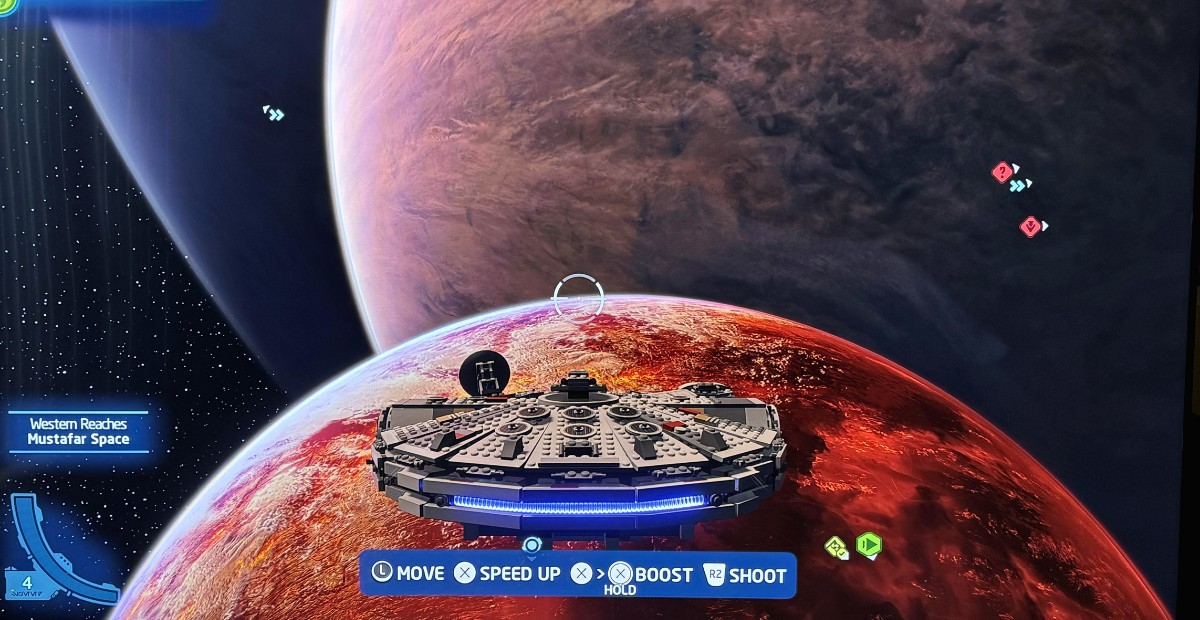So there I was, playing LEGO Star Wars: The Skywalker Saga, cruising around Mustafar’s space in the Millennium Falcon, when I couldn’t help but notice those two massive planets hanging in the background.
It got me thinking – are they just part of the scenery, or is there more to this setup?
I mean, does this make Mustafar a moon or what? Star Wars doesn’t always lay it all out, but there’s actually a ton to unpack here.
So, What’s in the Mustafar System?
The Mustafar system has a few key players, orbiting around a star named Priate. Here’s the lineup:
- Mustafar: The famous volcanic planet itself, known for its hostile landscape and that infamous duel between Obi-Wan and Anakin.
- Jestefad: A huge gas giant that’s one of Mustafar’s closest neighbors.
- Lefrani: Another massive gas giant hanging around nearby.
- Nur: An oceanic moon that orbits Jestefad, which also ends up being the Empire’s hideout for their Jedi-hunting squad, the Inquisitorius, later on.
These planets and moons all sit in a bit of a cosmic tug-of-war, creating a pretty chaotic environment, especially for Mustafar.
Jestefad – The Big Guy with a Strong Pull
Let’s talk about Jestefad. It’s a huge gas giant and a heavyweight in the Mustafar system.
This planet has some serious gravitational and electromagnetic power, and it’s constantly trying to pull Mustafar closer, almost like it wants Mustafar to be its moon.
Jestefad’s pull is so intense that it creates tidal forces on Mustafar, which could be part of why the planet is always erupting and spewing lava.
If you’ve seen those crazy electrical storms on Mustafar, you can thank Jestefad for that too.
The planet’s massive electromagnetic field sweeps over Mustafar, stirring up all kinds of wild weather.
So, whenever you see Jestefad looming behind Mustafar, know it’s not just for show – it’s actually messing with Mustafar’s entire ecosystem.
And Then There’s Lefrani, the Other Gas Giant
Jestefad isn’t the only one trying to yank Mustafar around. There’s another gas giant, Lefrani, that’s also close to Mustafar.
These two giants aren’t content with just floating by – they’re in a gravitational tug-of-war over Mustafar, each trying to drag it into their orbit.
This constant back-and-forth is one of the reasons Mustafar is so unstable. You’ve got two massive gas giants pulling on it from both sides, keeping it in this weird, erratic orbit.
The effect of this “tug-of-war” setup? Mustafar is left in a state of constant volcanic activity and instability, with its crust constantly shifting and erupting.
It’s a bit like the Star Wars version of being caught between a rock and a hard place – except, in Mustafar’s case, it’s between two giant planets.
Is Mustafar a Moon or a Planet?
Now, the big question: does this setup make Mustafar a moon? Technically, it doesn’t.
Even though it’s being yanked around by two bigger planets, Mustafar is still classified as a planet in Star Wars lore. It orbits the same star, Priate, as Jestefad and Lefrani.
But because it’s caught in the gravitational fields of these gas giants, it does look and act a lot like a moon, especially when you see those huge planets dominating its sky.
In fact, when you see Mustafar floating with Jestefad or Lefrani in the background, it might remind you of the moons in our own solar system, like Io orbiting Jupiter or Titan around Saturn.
But in Star Wars terms, Mustafar stands alone as a planet – just a small one constantly bullied by its bigger neighbors.
How Mustafar Got Stuck Here
According to Star Wars lore, Jestefad and Lefrani didn’t always hover so close to Mustafar. Ages ago, these two gas giants were in more stable orbits around Priate, the system’s sun.
But then, a massive battle between Jedi and Sith messed with the balance, pulling Jestefad and Lefrani out of their normal paths and closer to Mustafar.
Now, Mustafar sits between these two gravitational giants, getting pulled back and forth, which turned it into the unstable volcanic nightmare we know today.
This backstory adds a bit of epicness to the whole setup. It’s like even the planets in Star Wars can’t escape the drama of the Jedi-Sith conflict.
And Let’s Not Forget About Nur
Nur might not be as huge as Jestefad or Lefrani, but it’s still an important part of the Mustafar system. Nur is actually a moon that orbits Jestefad, and it’s mostly covered in oceans.
You might recognize it as the location for the Inquisitorius headquarters, the Empire’s base for their Jedi-hunting agents.
If you’ve watched Obi-Wan Kenobi or played Jedi: Fallen Order, you’ve seen it in action.
Nur’s orbit around Jestefad places it within view of Mustafar, so if you’re on the surface of Mustafar, you might even catch a glimpse of Nur in the sky, adding to the crowded cosmic landscape.

